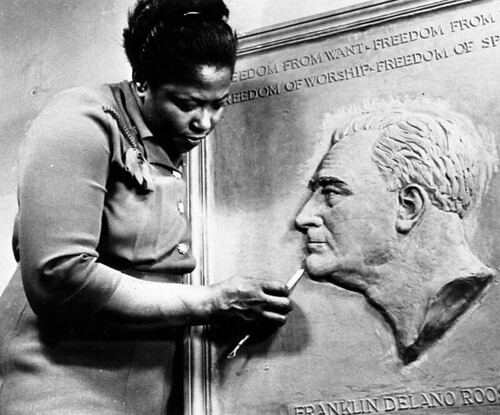
PREV ARTICLE
NEXT ARTICLE
FULL ISSUE
PREV FULL ISSUE
BURKE VS. SINNOCK: WHO DESIGNED THE DIME?The Atlas Obscura blog published a piece January 17, 2018 on the old controversy over the designer of the Roosevelt dime. It's a good summary of the events and facts.
Here's an excerpt. Be sure to read the complete article online. -Editor
 WHEN WAS THE LAST TIME you looked—really looked—at a dime? It is the smallest coin in U.S. circulation, so it takes a keen eye to see the very subtle “JS” just beneath Franklin D. Roosevelt’s truncated neck. These are the initials of John Sinnock, the U.S. Mint’s Chief Engraver from 1925 to 1947, who is credited with sculpting the profile of the 32nd president. However, institutions such as the Smithsonian American Art Museum—and even Roosevelt’s son—credit another sculptor with inspiring the design: Selma Burke, the illustrious Harlem Renaissance sculptor. So where is credit due? The answer is … complicated. In 1943, 43-year-old Selma Burke won a Commission of Fine Arts competition and a rare opportunity to sculpt the president’s likeness for the new Recorder of Deeds Building in Washington, D.C. Burke, renowned for her Booker T. Washington bust, ran into some problems, since she didn’t feel that photographs captured Roosevelt’s stature. So the sculptor wrote to the White House to request a live-sketch session. The administration, to her utter shock, agreed. On February 22, 1944, Burke met with Roosevelt for 45 minutes, sketched his profile on a brown paper bag, and engaged in a lively conversation about their childhoods. At one point, Burke said, “Mr. President, could you hold your head like this?” He invited her back for another session the following day. About a year later, just months before Roosevelt’s death, Eleanor Roosevelt visited Burke’s home in New York to see the profile-in-progress. The first lady told her, “l think you’ve made Franklin too young.” To which Burke replied, “I didn’t make it for today, I made it for tomorrow and tomorrow.” Roosevelt died five months before the official unveiling of the plaque, in September 1945. To commemorate his legacy and his founding of the March of Dimes to combat polio, the U.S. Mint and Congress proposed engraving his portrait on the dime, which at that point held the profile of the goddess Liberty wearing a winged cap. U.S. Mint Director Nellie Tayloe Ross (the first woman elected governor, in Wyoming), tapped Sinnock for the job. The dime’s most vocal critic was Burke. She claimed that the dime bore a striking resemblance to her portrait. Edward Rochette, former American Numismatic Association president, supported her argument, and went a step further, suggesting that the reverse of the dime was also inspired by the Four Freedoms sculpted into Burke’s plaque, though it’s not entirely clear how. According to Rochette, Sinnock allegedly had also taken undue credit for the design of the Sesquicentennial of Independence half-dollar coin, which he sculpted based on sketches by another artist, John Frederick Lewis, after Sinnock’s own designs were rejected. Burke believed the administration change after Roosevelt’s death and her political affiliations were reasons her claims were dismissed. When she demanded an investigation into Sinnock, Burke said the FBI investigated her instead.  U.S. Mint officials cite Sinnock’s previous Roosevelt work as evidence that his initials on the coin are warranted. Brenda Gatling, a former U.S. Mint public spokesperson, told Litt that “both Ms. Burke and Sinnock conducted live sittings with the president” for their designs. Current U.S. Mint Curator Robert Goler states that, according to archival records, Sinnock began sculpting Roosevelt in 1936 for “a presidential medal,” and that he “used that particular design of Roosevelt multiple times between then and the president’s death in 1945, and it’s the same the design” on the dime. (Though the 1936 medal and dime profiles face opposite directions). To read the complete article, see: In a 2006 E-Sylum article, Dick Johnson stated his belief that John R. Sinnock rightfully deserves credit for the dimes design. -Editor
I have examined enlarged photographs of both FDR portraits. Both are round, with similar view of the president, both face the same way and both are in modulated bas-relief. That is the extent of the similarity. If you examine minor points of the placement of features, the characteristics of the ear and hair plus the eyebrows you will learn, as I have, that Sinnock's design is 100 percent original, that he did the dime model entirely without any influence of Selma Burke's bas-relief model. I must admit I did not do an even more conclusive test - an overlay of photographic negatives both to the same scale. That would improve the odds of proving Sinnock's original creation I'm sure. Burke was a talented sculptor, educator and her portrait of the 32nd president is exquisite. But it is NOT the portrait which was placed on the Roosevelt dime. To read the earlier E-Sylum article, see:  Wayne Homren, Editor The Numismatic Bibliomania Society is a non-profit organization promoting numismatic literature. See our web site at coinbooks.org. To submit items for publication in The E-Sylum, write to the Editor at this address: whomren@gmail.com To subscribe go to: https://my.binhost.com/lists/listinfo/esylum All Rights Reserved. NBS Home Page Contact the NBS webmaster 
|